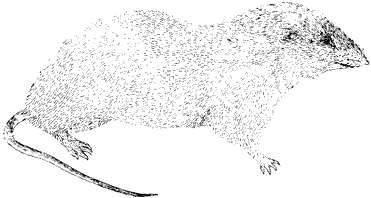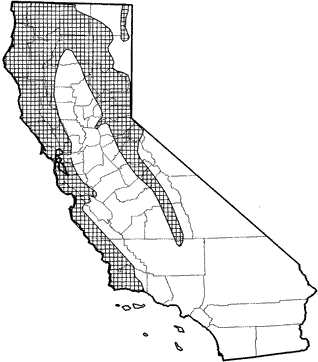
Trowbridge's Shrew
Distribution, Abundance, and Seasonality
Trowbridge's shrew is common in mature coniferous forests of the Pacific Coast, Sierra Nevada, and Cascades, ranging south along the coast to Santa Barbara Co., and in the Sierra Nevada to Kern Co. This shrew is most common in redwood, Douglas-fir, ponderosa pine, montane hardwood-conifer, and mixed conifer forests with well-developed shrub understories and litter layers. Also occurs in montane riparian, valley foothill hardwood and hardwood-conifer, red fir, and chaparral habitats. In the Sierra Nevada, the species is found from 1190-2340 m (3800-7500 ft) (Grinnell and Storer 1924).

Range Map
Specific Habitat Requirements
Feeding: Major foods include insects, spiders, centipedes and worms. Has been reported to eat the seeds of Douglas-fir (Moore 1942), and will eat a variety of seeds, as well as animal foods, in captivity (Terry 1978). This shrew forages in litter and moss, as well as in burrows.
Cover: This shrew is closely associated with a well-developed litter layer and ground cover of shrubs. Often establishes runway systems and burrows.
Reproduction: Nests under logs or in shallow holes.
Water: No data found, but unlike many other shrews, distribution not closely tied to water, suggesting that drinking water may be unnecessary.
Pattern: Prefers mature stands of coniferous forest with dense, brushy ground cover and litter, with uncompacted soil. Compacted soil or clear-cutting reduces numbers of this shrew.
Species Life History
Activity Patterns: Yearlong circadian activity (George 1989). May be active at any time of day or night.
Seasonal Movements / Migration: No data found.
Home Range: No data found.
Territory: No data found.
Reproduction: Trowbridge's shrew mates from February to May. Pregnancies occur from April to May, and most births occur during April to June. Average litter sizes reported include 5 (range 1-6) (Jameson 1955) and 3.8 (range 3-5) (Gashwiler 1976b). Postpartum pregnancy is common, and this species frequently has 2-3 litters per yr. The breeding season may be earlier, or later, depending on the sun exposure of a particular site (Jameson 1955).
Niche: This forest-dwelling shrew occurs with several others, including Sorex vagrans, S. monticolus, and S. pacificus. Trowbridge's shrews are less tied to water in their distribution, and are more closely associated with the litter layer of mature forests, rather than forest openings and herbaceous layers. Dalquest (1941) suggested that Trowbridge's shrews are outcompeted by vagrant shrews in wet areas in Washington. Terry (1981) suggested that Trowbridge's shrews avoid moist areas because of their preference for burrowing and foraging in litter, and suggested that vagrant shrews are outcompeted in drier areas. No data found to distinguish microhabitat selection from competition for these species. Owls, weasels, and Pacific giant salamanders are predators.
Sources & References
California Department of Fish and Game, 1999.
California's Wildlife, Sacramento, CA.
Written by: J. Harris, reviewed by: H. Shellhammer, edited by: S. Granholm
Dalquest, W. W. 1941. Ecological relationships of four small mammals in western Washington. J. Mammal. 22:170-173. Dalquest, W. W. 1948. Mammals of Washington. Univ. Kans. Publ., Mus. Nat. Hist. 2:1-444. Gashwiler, J. S. 1976b. Notes on the reproduction of Trowbridge shrews in western Oregon. Murrelet 57:58-62. George, S. B. 1989. Sorex trowbridgii. Mammal. Species No. 337. 5pp. Grinnell, J., and T. I. Storer. 1924. Animal life in the Yosemite. Univ. California Press, Berkeley. 752pp. Ingles, L. G. 1965. Mammals of the Pacific states. Stanford Univ. Press, Stanford, CA. 506pp. Jameson, E. W., Jr. 1955. Observation on the biology of Sorex trowbridgii in the Sierra Nevada, California. J. Mammal. 36:339-345. Moore, A. W. 1942. Shrews as a check on Douglas-fir reproduction. J. Mammal. 23:37-41. Terry, C. J. 1978. Food habits of three sympatric species of insectivora in western Washington. Can. Field-Nat. 92:38-44. Terry, C. J. 1981. Habitat differentiation among three species of Sorex and Neurotrichus gibbsii in Washington, USA. Am. Midl. Nat. 106:119-125. Tevis, L., Jr. 1956. Responses of small mammal populations to logging of Douglas-fir. J. Mammal. 37:189-196. Whitaker, J. O., Jr., and C. Maser. 1976. Food habits of five western Oregon shrews. Northwest Sci. 50:102-107.
California Animal Facts | California's Wildlife